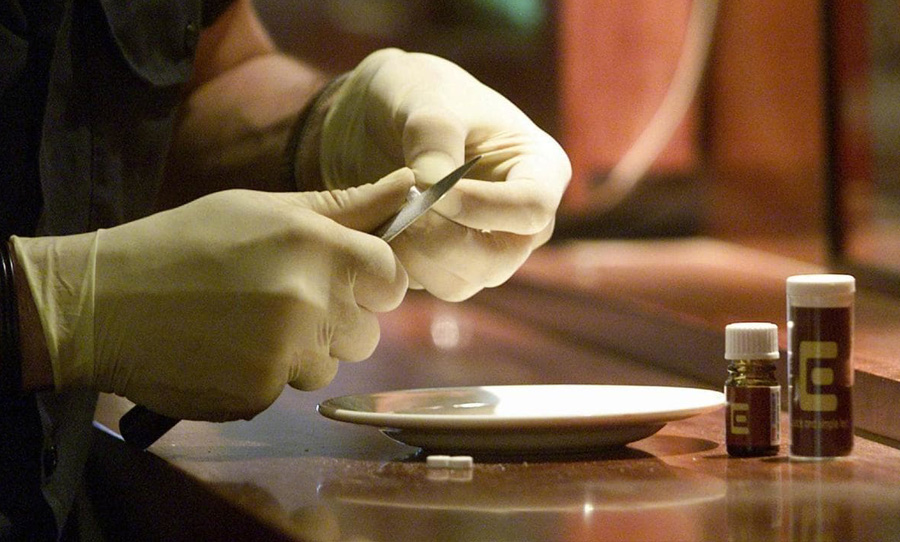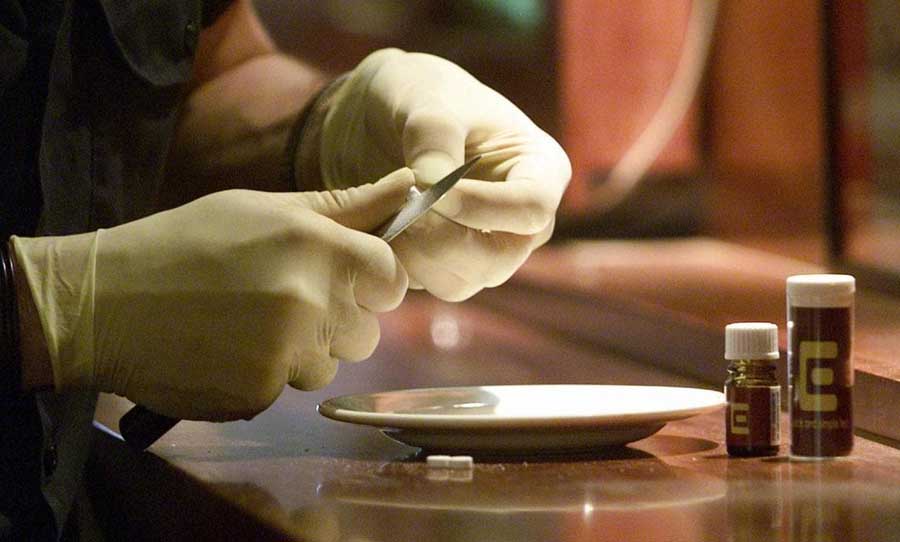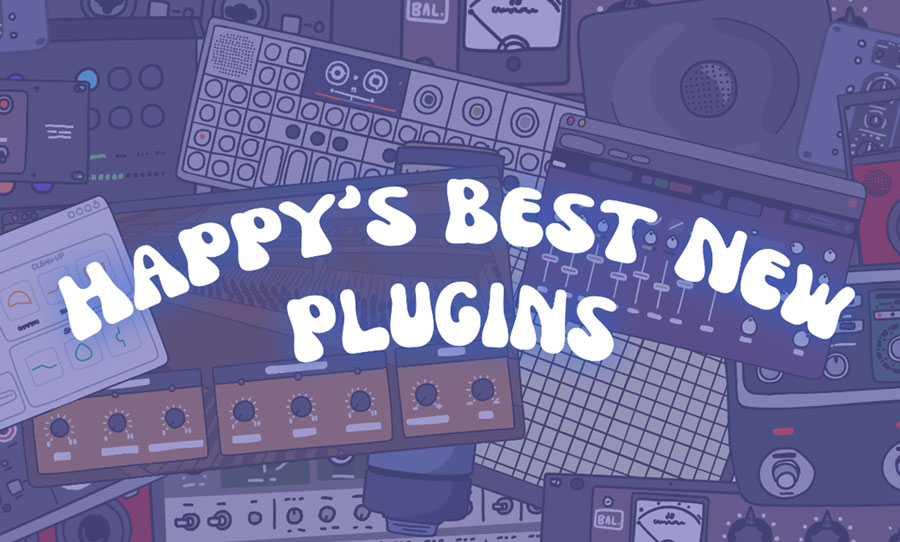This article appears in print in Happy Mag Issue 10: The Drug Issue. Grab your copy here.
It was 2:30pm on a Friday when Gregg Romaine finished class and began his commute home. With the warmth of the spring sun on his back, Gregg keenly anticipated the weekend ahead, especially with the knowledge that his parents were on holidays.
His younger brother John was already taking advantage of the situation with a combination of cannabis and Rick and Morty. The pair were relatively accustomed to substance use and had shared a few experiences together, so with a free house and a sunny afternoon, the brothers thought it high time for something special.

What are Research Chemicals and what part do they play in today’s drug landscape? We speak to Jessie Ray of DanceWize about these so-called ‘New Psychoactive Substances’.
A friend had been sitting on some blotter tabs with a ‘Monopoly game board’ design, which by 5pm were sitting under the brothers’ tongues. But before long, Gregg noticed a stimulated feeling and that the drug’s effects seemed stronger than what he was used to. He stated in a Reddit post:
“I remember sitting in the family room and seeing my brother stumble around and fall over. I should have noticed something odd, but I was heavily under the influence and lost in my own thoughts. I wrote it off as him tripping hard or perhaps being silly.”
The next thing Gregg remembers was laying in his room, staring at the back of his eyelids. At 9pm he was overcome by a strange feeling and decided to check on his brother.
“What I saw next may haunt me for the rest of my life. I saw my brother lying on his back in the family room with vomit trails down either side of his mouth. My stomach immediately dropped. Had everyone’s worst nightmare become a reality?”
“Upon arriving at the hospital, I received the news that I had most feared. They had failed to bring my brother back. I sat down in shock. What was supposed to be a fun bonding experience with my brother had turned into our last moments together.”
The reaction was an extreme one for a psychedelic trip, however, the blotter tabs that Gregg had purchased did not contain LSD. They contained the chemical 25B-NBOMe, a drug belonging to a class of substituted amphetamines called N-benzyl phenethylamines, known to cause vasoconstriction. The coroners found that John suffered an arrhythmia which led to cardiac arrest.
Now despite the horrible story, this isn’t a “drugs are bad mkay” article. People will continue to alter their brains as they have done for millennia, no matter the opinion of parents, politicians, or the baby-boomer next door whose cat you feed sometimes.
Instead, I would like to use this space to spread awareness of a group of substances known as ‘Research Chemicals’.
The definition of these drugs is rocky at best, so to help get the facts straight I consulted Jessie Ray, coordinator of harm minimisation advocacy group DanceWize. If you haven’t heard of them, DanceWize is a program of the NSW Users and Aids Association, and you’ll probably see them camped out at your next festival. If you do, say hi to Jessie and thank them for their awesome work. It goes without saying, they know their stuff.
Research chemicals, or RCs as you might see them called on forums, are lesser known substances still in the research phase. According to Jessie, ‘research chemicals’ is a bit of an outdated way to describe these substances.
“‘Research chemicals’ are coming to be known by the more accurate moniker ’novel / new psychoactive substances’ aka ‘NPS’, and they refer to lesser-known compounds that are often sold as substitutes to well-known substances such as LSD, MDMA, Ketamine, Cannabis etc. They can often mimic the effects of existing substances.”
NPS it is then. As Jessie explains, these substances can be new or old, but the defining factor is that they are beginning to find their way into ‘new cultures’ of use. So at what point are research chemicals not… research chemicals? Well, that comes down to the substances being established in the public and medical consciousness.
“In terms of transitioning from an NPS to a classic psychoactive substance, 2CB is an interesting one, as it’s nearly at the point where it might be considered a classic. It has been around a long time, the effects have been documented for some time and there is much more awareness of it in local subcultures – moreover, its usage as a recreational substance is more accepted. Perhaps it might be one of the first to transition to being no longer considered an NPS.”
Where do these compounds come from? According to The European Monitoring Centre for Drugs and Drug Addiction (EMCDDA), many of these substances were originally produced within “the good intentions of pharma and academia”.
They were perhaps never commercialised as they caused strange symptoms, or they just didn’t quite work as designed. NPS’s have, however, also emerged in underground laboratories, either from replicating these lesser-known substances or tinkering with the molecular structure of better-known chemicals such as LSD or MDMA.
Jessie describes a case example, MXE or Methoxetamine which “was sold as a legal replacement for ketamine, initially slated to be an alternative which didn’t negatively impact the urinary tract, but it turned out to actually be even worse for it, as well as the added complications of compulsive redosing, higher potency, and a much longer length of effect.”
And what about the substance that killed John Romaine? Well, 25B-NBOMe is a close derivative of 25I-NBOMe (also called N-Bombs), which Jessie states is an “intense psychedelic drug that was originally synthesised as a way to map the brain’s use of type 2A serotonin receptors”.
NPS’s have built up a bit of a reputation, presumably due to their notoriety for escaping the law. As they’re not traditional drugs that have already been scheduled, many of these substances have been legal to sell with the label “not for human consumption”. An example you’ve probably heard of were a group of stimulants legal and purchasable while they were labelled as “bath salts”.
For a while, NPS’s were only known by the savviest drug anarchists and the most far-out of the psychonauts. That is, until they started causing problems. Dealers found out that they could purchase these chemicals legally, for cheap and in bulk, marketing them as other substances.
25B-NBOMe, for instance, can be purchased for under $2 a hit. So when teenagers buy it, thinking it’s LSD, and end up in critical condition, you get a picture of the seriousness of the situation.
Legislators have gradually caught on. In Australia, a stream of deaths and ensuing media panic lead to 25I-NBOMe being made illegal in Queensland in 2012, while in New South Wales, 25I-NBOMe and some related compounds were scheduled in 2013. Despite this, the Federal Government has no legislation for any substances of the N-benzyl phenethylamines, and who’s to say that underground chemists can’t just tweak the molecule again?
The situation could be likened to a game of cat and mouse, where the black market continues to cook up unknown and potentially dangerous drugs while remaining one step ahead of the law. And meanwhile, LSD, a more researched substance with a considerably lower danger profile than any of the NBOMe series, remains illegal.
It makes you think, if LSD was legal and regulated, or in the least, decriminalised, would this diminish the prevalence of more harmful compounds?
So are NPS’s all evil chemicals to be avoided? Well, no. That’s a simplification of the facts and, in the end, drugs are still drugs. NPS’s are just less documented.
“The dangers of NPS’s are the same as the dangers of any other chemical compound. If you were taking what you thought was Panadol for a headache, and actually you were taking Nurofen, there would be potential for adverse effects, because you’re not taking what you thought you were for the intended outcome.”

So how can you be safe and certain of what you’re taking? Well, the short answer is, you can’t, but there are a lot of precautions you can take.
An obvious step is testing your compounds with a kit, as Jessie states, “Reagent tests are far from perfect but support drug users to seek information and consider their options. Even testing done via infrared spectrometry is not perfect as quite a few of the festival deaths we’ve seen in the past few years have been caused by people taking the substance they intended.”
Some people, despite the cautionary tales, will still want to try NPS’s for themselves. Jessie stresses that to mitigate risk “we can educate ourselves on best practice when using an NPS, rather than assume that they are more or less toxic – this is often a sensationalised and fear-based tactic used by the media to further stigmatise drug use.”
Some of these substances have been documented online, and there are websites and chat rooms that list users’ experiences with dosage and effects. But of course, trips are hardly the same for everyone.
“It’s important to keep in mind however, that everyone’s body and brain can react differently to the same substance, so it’s tricky to assume that a psychonaut’s advice is accurate. Any number of factors can change this experience for the user.”
So whether your intention is to take an NPS or if it’s to avoid one at all costs, the answer is the same; educate yourself and make sure you’re taking all the necessary precautions. Despite drug prohibition, it doesn’t look like New Psychoactive Substances or more widely-used drugs are going anywhere anytime soon, so the best step for those intending to dabble is to be aware.
“The safest way to avoid all drug-related harm is to refrain from taking drugs at all including alcohol and tobacco. NUAA also believes that a regulated supply of substances like cannabis, MDMA and LSD would greatly reduce the risks.”
This article appears in print in Happy Mag Issue 10: The Drug Issue. Grab your copy here.



